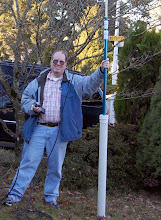My wife and I drove from home to Seaside, Oregon for the 2009 ARRL NW Division conference. the drive west through the forests in Tillamook Burn towards the coastal gray sky reminded us both of our time at school some years ago. Once at Seaside, I headed to the Convention Center for a two hour security assignment. That was the time vendors and fleamarketeers set up their tables. The hall looked like a beehive.... After my shift, we went hunting for geocaches in the area.
On Saturday, I walked the dozen or so blocks from our lodging to the Convention Center. I talked with several other hams in the lobby while waiting for the doors to open at 9 AM. Promptly at 9, security removed the barrier and the crowd surged into the hall. I took a side trip to visit with the OR and WA frequency coordination group leaders. I gained a better appreciation for the role of frequency coordination, and found them willing to consider reasonable proposals. I would like to see more simplex frequencies available in the metro area for use during emergencies, but most repeater owners (who make up the repeater council) want more, not less, repeater frequencies. I plan to send a firm proposal later this week.
Next I headed upstairs for my talk on ham training. In my talk, I started off with seven maps that show ham demographics in the US. California has the most hams, but their ham population declined by over 12,000 in the past decade. Washington state has the second highest hams per thousand in the general population behind Alaska. Ham populations in many states declined, while the ham population in the NW increased over the past decade. The western states have a higher proportion of female hams than most other states. At the current growth rate ,Washington should attain the fifth highest ham population in the US. We continue to increase ham numbers while other areas are in decline.
After the demographics, I suggested methods for effectively teaching ham classes. We had some good discussion on teaching methods. The had about 60 seats and about 3/4 were occupied, which is more than triple than last year. I plan to polish the discussion and submit an article to QST.
After my talk, I visited nearly every commercial booth to check out their wares. The new Icom HF radios (http://www.icomamerica.com/) look quite interesting but spendy. Maybe my interests and bank account will converge one of these days. Ham Radio Outlet (http://www.hamradio.com/) sold quite a few new radios; a friend bought an Icom 7000 (nice radio), and another friend bought a Yaesu FT-8900 quad band FM radio. I think both of my friends will be happy with their choices. One of these days I may sell one of my radios and trade up.
The Buddipole antennas (http://www.buddipole.com/) look like something I want to try later this year. The portablility and flexibility in the Buddipole Deluxe Package would suit my interests in portable operations. I bought two of their standard telescopic whips (http://www.buddipole.com/stainsteelte.html) for use as a six meter antenna during the ARRL VHF QSO party (www.arrl.org/contests/rules/2009/june-vhf.html) next weekend. I already have the duplex connector that I use with hamsticks to make an HF dipole.
I also looked closely at the yagi in a bag offered by SuperAntennas (http://www.superantennas.com/). I like the concept and flexibility (they even offer a rotator), and will need to consider this one later.
One other item I purchased was a teflon disk that should protect the roof paint of my car from the magnetic antenna mount. I hope that eliminates the chance of rust rings and direct wear on the paint.
If you have the chance to attend one of the ARRL conventions, the talks and vendor displays are usually well worth the price of admission. I came away with some new ideas.
Sunday, June 7, 2009
Subscribe to:
Comments (Atom)



